EVGA's GeForce GTX 560 Ti 2Win: The Raw Power Of Two GPUs
by Ryan Smith on November 4, 2011 11:00 PM ESTCrysis: Warhead, BattleForge, & Metro 2033
As we mentioned previously, the EVGA GeForce GTX 560 Ti 2Win is a one-off product. At $520 It doesn’t have any specific competition – at least none that’s reciprocal – but EVGA likes to call it a GTX 580 competitor it’s definitely priced close enough to the GTX 580 to make that a meaningful comparison. As a multi-GPU product it also competes with multi-GPU multi-card setups, primarily the regular GTX 560 Ti SLI and the Radeon HD 6950 CF.
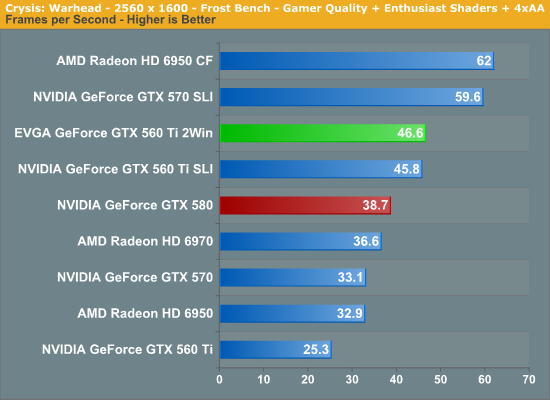
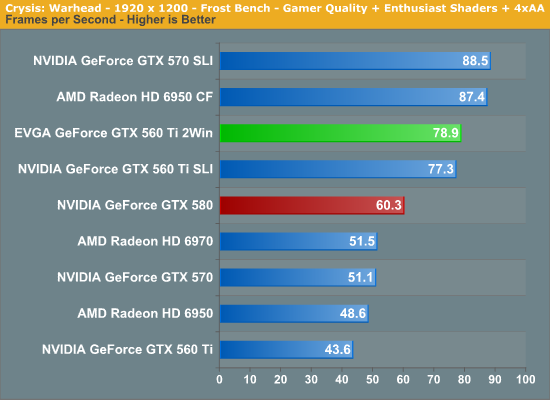
Starting as always with Crysis, we get a good setup for the rest of the benchmarks to come. The 2Win is well ahead of the similarly priced GTX 580, turning in a score 30% better than the 580. At the same time its performance relative to the GTX 560 Ti SLI is almost identical, owing to the 2Win’s 3% higher core clock. At no point here will the GTX 560 Ti SLI and 2Win ever separate by an appreciable margin; it’s really only faster on paper.
Looking at raw performance, we see that the 2Win turns in a solid performance at 2560 and is well above 60fps at 1920. SLI doesn’t change the fact that AMD and NVIDIA will regularly jockey for position depending on the game, so even with a strong showing here, the 6950 CF still ends up being quite a bit faster.
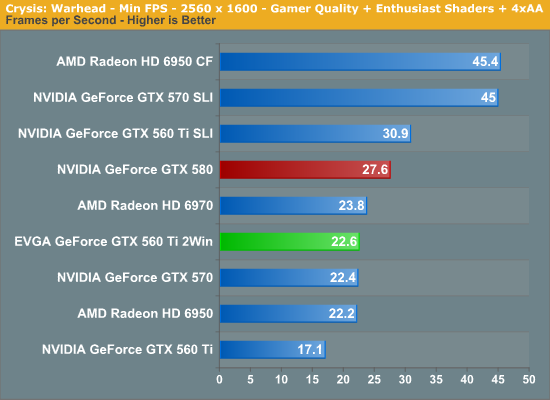

The Crysis minimum framerate test is one of the handful of tests we have right now that pays much attention to more than 1GB of VRAM. The fact that the 2Win does worse than the regular GTX 560 Ti SLI is not a mistake here – it’s a telltale sign of swapping into VRAM. The 2Win is generally capable of handling 2560 in terms of rendering power, but with 1GB of effective VRAM it can run into other bottlenecks first, as we see here.
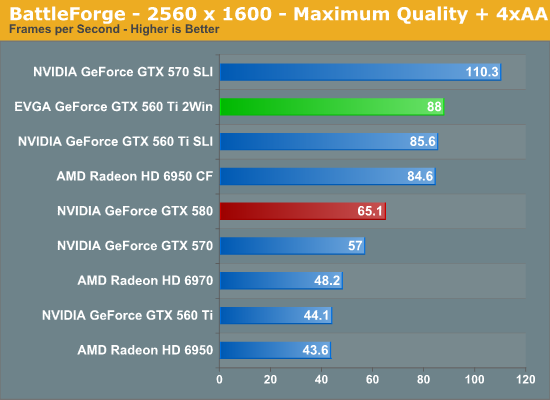
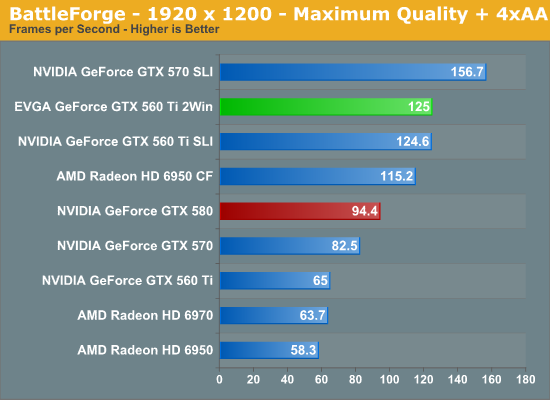
Given that it’s a good deal more powerful than the GTX 580, the 2Win has no problem breezing through Battleforge. Even at 2560 it hits 88fps, 35% better than the GTX 580.
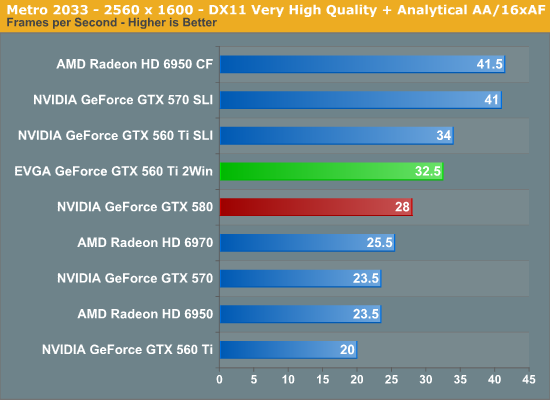
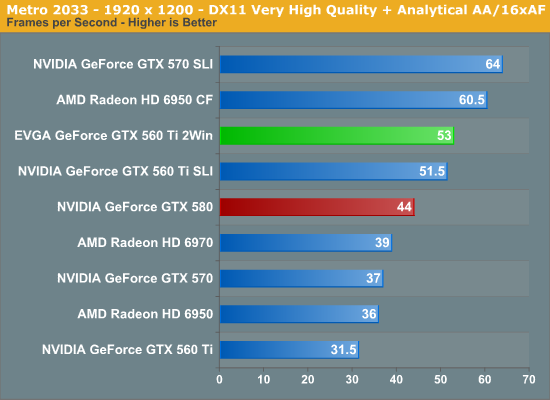
When it comes to SLI scaling Metro has always been a challenge, and as a result the 2Win loses some of its advantage here. It’s still ahead of the GTX 580 at 2560, but only by 16%. Again we’re looking at a potential lack of VRAM, but also the result of Metro’s significant workload at 2560. This is one of the only titles we currently use that is still a struggle for every card we have, and as a result it’s one of the few titles than the 2Win just isn’t cut out for at 2560. It’s only at 1920 that the 2Win can pick up enough speed to be playable, at which point its lead over the GTX 580 grows slightly to 20%.










56 Comments
View All Comments
luv2liv - Friday, November 4, 2011 - link
they cant make it physically bigger than this?im disappointed.
/s
phantom505 - Friday, November 4, 2011 - link
That was so lazy.... it looks like they took 3 case fans and tie strapped them to the top. I think I could have made that look better and I have no design experience whatsoever.irishScott - Sunday, November 6, 2011 - link
Well, it apparently works. That's good enough for me, but then again I don't have a side window.Strunf - Monday, November 7, 2011 - link
Side window and mirrors to see the the fans...I don't understand why people even comment on aesthetics it's not like they'll spend their time looking at the card.phantom505 - Monday, November 7, 2011 - link
If they were lazy here, where else were they lazy?Sabresiberian - Tuesday, November 8, 2011 - link
What is obviously lazy here is your lack of thinking and reading before you made your post.Velotop - Saturday, November 5, 2011 - link
I still have a GTX580 in shrink wrap for my new system build. Looks like it's a keeper.pixelstuff - Saturday, November 5, 2011 - link
Seems like they missed the mark on pricing. Shouldn't they have been able to price it at exactly 2x a GTX 560 Ti card, or $460. Theoretically they should be saving money on the PCB material, connectors, and packaging.Of course we all know that they don't set these price brackets on how much more card costs over the next model down. They set prices based on the maximum they think they could get someone to pay. Oh well. Probably would have sold like hot cakes otherwise.
Kepe - Saturday, November 5, 2011 - link
In addition to just raw materials and manufacturing costs, you must also take in to account the amount of money poured in to the development of the card. This is a custom PCB and as such, takes quite a bit of resources to develop. Also, this is a low volume product that will not sell as many units as a regular 560Ti does, so all those extra R&D costs must be distributed over a small amount of products.R&D costs on reference designs such as the 560Ti are pretty close to 0 compared to something like the 560Ti 2Win.
Samus - Saturday, November 5, 2011 - link
i've been running a pair of EVGA GTX460 768MB's in SLI with the superclock BIOS for almost 2 years. Still faster than just about any single card you can buy, even now, at a cost of $300 total when I bought them.I'm the only one of my friends that didn't need to upgrade their videocard for Battlefield 3. I've been completely sold on SLI since buying these cards, and believe me, I'd been avoiding SLI for years for the same reason most people do: compatibility.
But keep in mind, nVidia has been pushing SLI hard for TEN YEARS with excellent drivers, frequent updates, and compatibility with a wide range of motherboards and GPU models.
Micro-stutter is an ATI issue. It's not noticeable (and barely measurable) on nVidia cards.
http://www.tomshardware.com/reviews/radeon-geforce...
In reference to Ryan's conclusion, I'd say consider SLI for nVidia cards without hesitation. If you're in the ATI camp, get one of their beasts or run three-way cross-fire to eliminate micro-stutter.